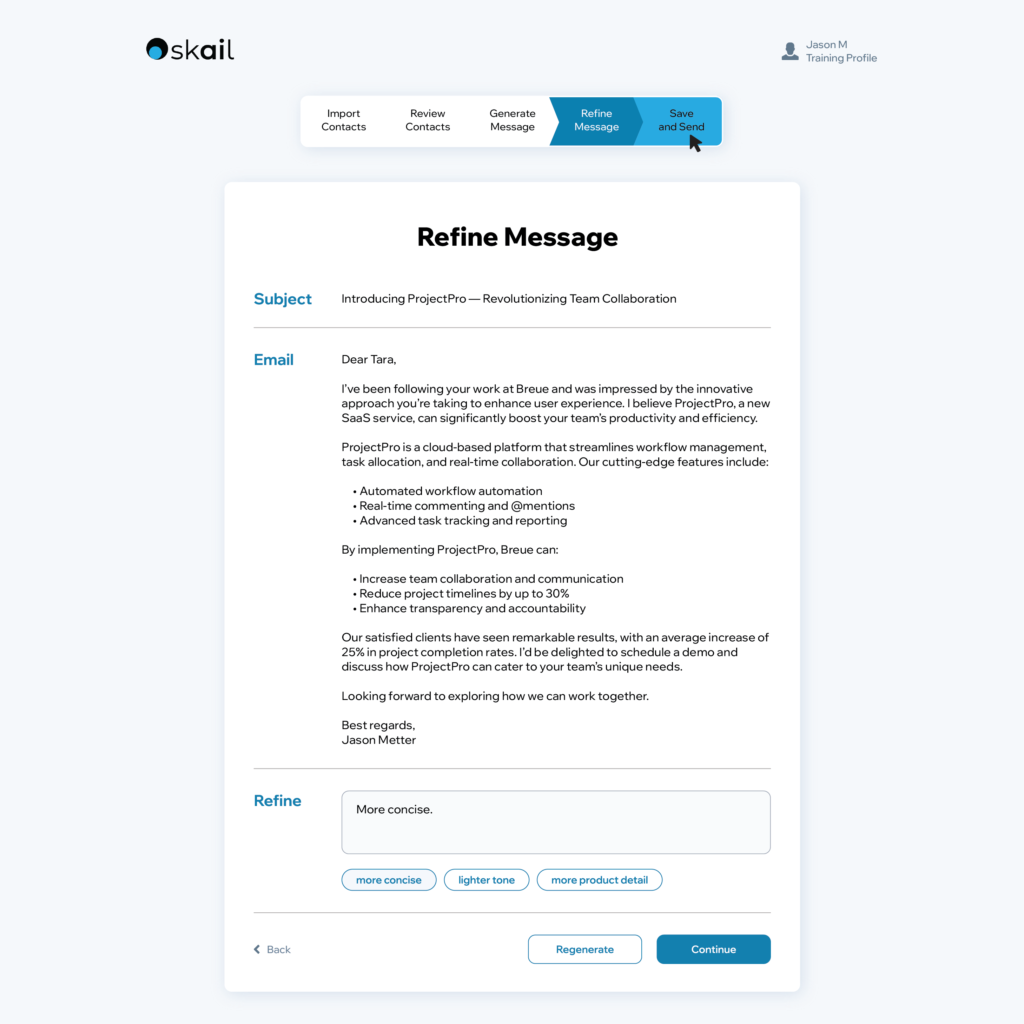Alright, folks, gather around! We’re about to dive into the mysterious, sometimes frustrating, but ultimately rewarding world of email outreach for backlinks. Yes, we’re talking about the kind of outreach where you send emails to strangers on the internet and politely ask them to do you a favor. Sounds awkward, right? Well, fear not! With the right backlink email template, you’ll be slinging emails that not only get responses but land those sweet, sweet backlinks you crave.
But before we go full throttle into template-land, let’s address the elephant in the room. A great email outreach for a backlinks campaign isn’t about copying and pasting the same generic email over and over. Nope. Personalization is key, my friend. You’ve got to give it that personal touch—like when you tell your favorite barista, “You’re a magician,” after they make your coffee just right.
And hey, if you’re thinking, “This sounds like a lot of work!” I hear you. Luckily, we’ve got tools like Skail to automate and personalize emails. So, let’s jump in, explore the top email templates, and sprinkle in a little magic to make those responses (and backlinks) roll in.
The Backlink Email Template Hall of Fame
Here are some tried-and-tested backlink email templates, each with its own flavor. Think of them like different ice cream toppings—sprinkle some chocolate here, a few gummy bears there, and boom, perfection. I’ve crafted these just for you, so feel free to tweak them and add a dash of your own pizzazz!
1. The Classic Cold Email (But With Charm)
This is your go-to when reaching out to someone who’s never heard of you before. The key is to make it short, sweet, and to the point—like your favorite Twitter thread. Oh, and don’t forget to butter them up a bit.
Subject line: “🚀 Let’s Collaborate and Boost Our Sites Together!”
Hey [Recipient’s Name],
I hope you’re having a fantastic day! My name is [Your Name], and I’m the [Your Position] at [Your Company]. I was checking out your site, and I have to say, [specific compliment about their website or content]—it’s top-notch!
I’m reaching out because I’ve written a piece that aligns with your content, titled “[Your Article Title].” I think it would be a great fit for your readers and would add a ton of value to your blog. Would you be open to linking to it?
If there’s anything I can do to help you out in return (guest post, content collaboration, etc.), let me know. I’m all about win-win situations!
Thanks for your time, and I look forward to hearing from you.
Best,
[Your Name]
[Your Contact Info]
Why it works: It’s short, sweet, and personal. By complimenting their work, you show that you’ve done your homework. Plus, offering something in return makes it feel less like a one-sided ask.
2. The “I Found a Broken Link” Special
Everyone loves a good samaritan. Pointing out a broken link on someone’s site not only makes you seem helpful, but it opens the door to suggesting your own content as a replacement. It’s like saying, “Hey, your tire’s flat—but I just happen to have a spare!”
Subject line: “⚠️ Found a Broken Link on [Their Website’s Name]”
Hi [Recipient’s Name],
I was reading your awesome article, “[Article Title],” and noticed there’s a broken link in the section about [brief description]. I thought I’d give you a heads-up because I know how frustrating those can be!
If you’re looking for a replacement, I recently published a post on [Your Topic] that could be a good fit. Here’s the link if you want to check it out: [Your URL].
Thanks again for all the great content you put out—I’m a big fan of your work!
Best,
[Your Name]
[Your Contact Info]
Why it works: You’re providing value upfront by identifying a problem and offering a solution. And since you’re being helpful rather than just asking for something, they’re more likely to respond positively.
To run a quick broken link checker on someone’s site, simply go here. (also the source of the image below.)

3. The Guest Post Request
Guest posting is like the holy grail of backlinking. You get to write an article for someone else’s site, which gives you exposure and a backlink. Here’s how to ask without sounding like a used car salesman.
Subject line: “Let’s Create Some Content Magic Together!”
Hey [Recipient’s Name],
I’ve been reading [Their Blog Name] for a while now, and I’m hooked! Your article on [Specific Topic] really hit home for me—it’s clear you know your stuff.
I was wondering if you’d be open to a guest post collaboration? I’d love to write something on [Your Topic] that I think would resonate with your readers.
Let me know if you’d be interested, and I’d be happy to send over a few ideas!
Thanks for considering,
[Your Name]
[Your Contact Info]
Why it works: You’ve complimented their work, offered to create valuable content for them, and left room for collaboration. It feels more like teamwork than a favor.
4. The “I Featured You” Love Letter
Everyone loves recognition. If you’ve mentioned someone in your blog post, let them know—they might share it with their audience and link back to you in the process!
Subject line: “You’re Featured in Our Latest Post!”
Hey [Recipient’s Name],
I hope you’re doing awesome! I just wanted to drop a note to let you know that I featured your article “[Their Article Title]” in my latest post, “[Your Post Title].”
I’m a big fan of your work, and I wanted to give you a shout-out for all the great content you’re putting out there!
Here’s the link to the post: [Your URL]. Feel free to share it if you like—it’d be great to get your thoughts.
Thanks for all that you do!
Best,
[Your Name]
[Your Contact Info]
Why it works: Flattery gets you everywhere. You’re letting them know that you value their content enough to include it in your own, which increases the chances they’ll share it with their audience.
5. The “I Love Your Content” Outreach Email
This is your “fan letter” approach, where you butter up the recipient by genuinely appreciating their content before suggesting a backlink.
Subject line: “Your Content is Amazing—Let’s Collaborate!”
Hi [Recipient’s Name],
I’ve been a long-time reader of your blog, and your recent article on [Topic] was fantastic. I loved your insights on [specific aspect]—it really resonated with me.
I’m reaching out because I recently wrote a post on [Your Topic], and I think it would be a great addition to your resources on [Their Blog Topic]. It complements your content well and provides further value for your readers.
Here’s the link to check it out: [Your URL]. If you think it would be a good fit, I’d love for you to link to it in your article.
Thanks for considering! I appreciate all the great content you’re sharing with the world.
Best,
[Your Name]
[Your Contact Info]
Why it works: Sincere appreciation goes a long way. This shows you’re a genuine fan and not just trying to score a backlink.
6. The Skyscraper Technique Email
This one’s based on the famous “Skyscraper Technique” by Brian Dean, where you improve on an existing piece of content and suggest it as an even better resource.
Subject line: “I Found a Way to Improve [Their Article Title]!”
Hey [Recipient’s Name],
I was reading your post on [Topic], and it’s one of the best I’ve seen on the subject. You’ve covered a lot of ground, but I thought I could offer an updated resource that goes a bit deeper.
I’ve written a comprehensive guide on [Your Topic], including [new insights, updated stats, or additional tips]. I think it would be a great addition to your post as a valuable resource for your readers.
Here’s the link: [Your URL]. I’d love for you to check it out and see if it’s something you’d be interested in linking to.
Looking forward to hearing your thoughts!
Best,
[Your Name]
[Your Contact Info]
Why it works: You’re offering something new and improved, which is hard to resist for someone who’s serious about providing the best content to their audience.
7. The “Let’s Swap Links” Template
This is a classic link exchange email, where you offer a mutual backlink in exchange for one. Think of it as a “you scratch my back, I’ll scratch yours” situation.
Subject line: “How About We Swap Links?”
Hi [Recipient’s Name],
I came across your article on [Topic], and I think our audiences overlap quite a bit. I was wondering if you’d be interested in a link exchange? I’d be happy to link to your content in one of my relevant posts, and in return, I’d love for you to link to my article on [Your Topic].
I think this could be a win-win for both of us in terms of SEO and providing valuable resources to our readers.
Let me know if you’re open to the idea—I’d love to collaborate!
Cheers,
[Your Name]
[Your Contact Info]
Why it works: It’s straightforward, and you’re offering something of equal value, which makes the recipient more likely to say yes.
8. The “Content Upgrade” Offer
This template is great for when you have a more in-depth version of a topic someone has already covered. You offer it as a content upgrade that can add value to their readers.
Subject line: “I Have a Content Upgrade for Your Readers!”
Hi [Recipient’s Name],
I was reading your post on [Topic], and I love how you explained [specific part of their post]. I actually have an in-depth guide on a related topic, [Your Topic], that I think would serve as a great content upgrade for your readers.
Here’s the link to the guide: [Your URL]. It dives deep into [specific aspects], and I believe it would complement your existing content nicely.
Would you be interested in linking to it as a helpful resource for your audience?
Thanks so much for considering,
[Your Name]
[Your Contact Info]
Why it works: You’re adding value to their post by offering a more detailed or updated resource that enhances their content.
9. The “Podcast Guest Invite” Outreach
Have a podcast or YouTube channel? Use this template to invite someone to be a guest. Bonus: this often results in mutual backlinks once the episode goes live.
Subject line: “Join Me on My Podcast/YouTube Channel!”
Hi [Recipient’s Name],
I’ve been a fan of your work for a while, especially your take on [specific topic]. I’d love to invite you to be a guest on my [Podcast/YouTube Channel], [Your Podcast Name], where we discuss [relevant industry topic].
I think my audience would love to hear your thoughts on [Specific Area of Expertise], and it would be great exposure for both of us.
If you’re interested, we can set up a time that works for you. Let me know what you think!
Best,
[Your Name]
[Your Contact Info]
Why it works: You’re offering exposure, which can be appealing, and it’s a natural way to get a backlink when they promote the episode.
10. The “Thanks for the Mention” Outreach
If someone has already mentioned you or your brand, reach out and thank them, while subtly suggesting a backlink if they haven’t included one.
Subject line: “Thanks for Mentioning [Your Brand]!”
Hi [Recipient’s Name],
I noticed you mentioned [Your Brand/Article] in your recent post, “[Their Article Title].” Thank you so much for the shout-out—it means a lot!
I wanted to suggest that you could link to [Your Brand/Article] as a resource for your readers. I think it would provide them with additional context and value.
Thanks again for the mention—I’m happy to share your article with my audience as well!
Best,
[Your Name]
[Your Contact Info]
Why it works: They’ve already taken the first step by mentioning you, so asking for a backlink isn’t much of a stretch. Plus, offering to share their content gives them even more incentive to link to you.
11. The Resource Page Outreach
If you find a relevant resource page on a website, you can suggest your content as a valuable addition. Resource pages are often gold mines for backlink opportunities.
Subject line: “Suggestion for Your Resource Page”
Hi [Recipient’s Name],
I was browsing your excellent resource page on [Topic], and I noticed you have a lot of great links to valuable content.
I wanted to suggest adding my recent post on [Your Topic] to the page. It provides [brief description of your content’s value], and I think it would be a helpful resource for your audience.
Here’s the link if you’d like to check it out: [Your URL].
Thanks for considering, and keep up the great work on your site!
Best,
[Your Name]
[Your Contact Info]
Why it works: Resource pages are meant to link out to helpful content, so this kind of outreach is right in their wheelhouse.
12. The Infographic Outreach
If you’ve created a killer infographic, this template is perfect for reaching out and asking for a link.
Subject line: “Check Out This Infographic for Your Blog!”
Hey [Recipient’s Name],
I just created an infographic on [Your Topic], and I think it would be a perfect fit for your blog post, “[Their Article Title].”
The infographic breaks down [key points], and I believe it would provide a great visual element for your readers.
Here’s the link: [Your Infographic URL]. Feel free to use it if you think it adds value to your post!
Thanks for your time, and let me know if you’d like more info.
Best,
[Your Name]
[Your Contact Info]
Why it works: Infographics are easy-to-share, visually appealing resources, making it a low-effort addition for the recipient.
13. The Expert Roundup Participation Request
Hosting an expert roundup? This template is perfect for inviting people to contribute, which usually leads to backlinks when they share the roundup on their site.
Subject line: “I’d Love to Feature You in an Expert Roundup!”
Hi [Recipient’s Name],
I’m putting together an expert roundup on [Topic], and I’d love to include your insights. I’ve been following your work on [Their Blog/Website], and I think you’d have a unique perspective to share with our readers.
If you’re interested, could you answer this quick question: [Your Question]?
I’ll be sure to include a link back to your website when the post goes live!
Thanks so much for your time, and I hope to feature you in the roundup.
Best,
[Your Name]
[Your Contact Info]
Personalization Is Key: Don’t Be a Robot
Now, I know what you’re thinking: “This sounds like a lot of emails.” And you’re right! Sending out personalized emails for backlinks can be time-consuming. But here’s the thing—generic, copy-paste emails will get you nowhere. Personalization is the secret sauce that makes people actually want to help you out.
Mention specifics about their site, reference their recent posts, and address them by name. This shows you’re not just some internet rando—you’re a person who took the time to get to know their work. And trust me, that’s worth its weight in gold (or backlinks).
How Skail Can Help Automate Personalized Emails
Let’s talk about how Skail can step in to make your life easier. Skail automates the email outreach process but keeps the personal touch intact by pulling in website and personal data. Basically, it’s like having a superhuman assistant that crafts unique emails for each recipient based on their content and interests.

With Skail, you don’t have to manually write every email—just set it up to customize your outreach using data about the recipient’s website, and boom, you’re scaling your email campaign and keeping it personal.
Finding Backlink Opportunities: The Hunt Begins
So, where do you actually find these backlink opportunities? Here’s the secret sauce for finding the right websites to target:
1. SEMrush SEO Content Tool

Use SEMrush’s SEO Content Tool to analyze your competitors’ backlink profiles. This will show you exactly where they’re getting their backlinks from, and you can use that list to create your own outreach strategy. Go ahead, stalk your competitors—no judgment here.
2. BuiltWith for Scraping Websites
Want to dig up email addresses from a ton of websites in one go? Enter BuiltWith.com, a tool that scrapes publicly available data (like email addresses) from websites. It’s like a treasure hunt, except instead of gold, you’re finding contact info for your outreach campaign.
3. Use Your Own Backlink List
If your website already has backlinks, check out your list to see if there are opportunities for more. You can upload this list to tools like ZoomInfo, Seamless.ai, or Apollo.io to find more contact details for follow-up outreach.
Want to Outsource the Whole Shebang?
If all of this sounds like too much work (and you’d rather spend your time binge-watching Netflix), there are services that will do the outreach for you. Programs like Backlinko and Hoth are designed to handle backlink outreach from start to finish.
They find the contacts, write the emails, and do the follow-ups—leaving you to sit back and watch those backlinks roll in. It’s a little like hiring someone to mow your lawn—sure, you could do it yourself, but wouldn’t it be nicer to sip lemonade and let someone else handle the heavy lifting?
Keep in mind that these services come at a price – Each high Domain Authority backlink will cost hundreds of dollars. For those on a tight budget, they are typically out of reach.
Final Thoughts: Email Outreach for Backlinks & using backlink email templates
In the end, backlink outreach is a lot like dating: you’ve got to put yourself out there, make a good impression, and sometimes, be ready for rejection. But with the right email templates, a personalized touch and a bit of persistence, you can turn those cold emails into warm connections. It’s all about finding the right match—whether through broken links, guest posts, or content collaborations. Sure, not everyone will say yes, but when they do, you’ll land those quality backlinks that boost your SEO and help your site climb the search engine ranks.
So, take the time to personalize, show genuine interest, and keep things friendly. And don’t forget, tools like Skail can make the process smoother, automating personalization and outreach so you can scale without losing the human touch. Whether you go the DIY route or outsource the heavy lifting to services like Backlinko or Hoth, you’re well on your way to building a solid backlink profile.
Remember, backlinks might not grow on trees, but with the right approach, you can certainly harvest a bountiful crop. Now, go forth and conquer the backlink world!
Also, looking for easy backlinks? Use directories, social media, and other free listing websites. Sometimes these are “no follow” links – but they are great to drive traffic. We made a list of these websites in our blog “14 Easy Ways on How to Get Backlinks to Your Website”.



